Leadership Case Study: Analysis of Eternal Bliss Enterprise (EBE)
VerifiedAdded on 2022/08/24
|8
|2081
|13
Case Study
AI Summary
This case study examines the leadership practices within Eternal Bliss Enterprise (EBE), a leading hospitality group in Asia. The analysis focuses on Victoria, the head of EBE, and her shift from traditional management to a leadership approach that emphasizes shared responsibility and employee engagement. The report explores the adoption of transformational leadership, the implementation of shared or distributed leadership, and the impact of these approaches on organizational effectiveness. It also analyzes the application of leadership theories at individual, group, and organizational levels, highlighting the transition from a management-focused paradigm to a leadership-driven model. The study emphasizes the importance of ethical decision-making, employee skill development, and the alignment of leadership with strategic goals to achieve sustainable success in the hospitality industry. The case study also references academic literature to support the analysis of leadership theories and practices.
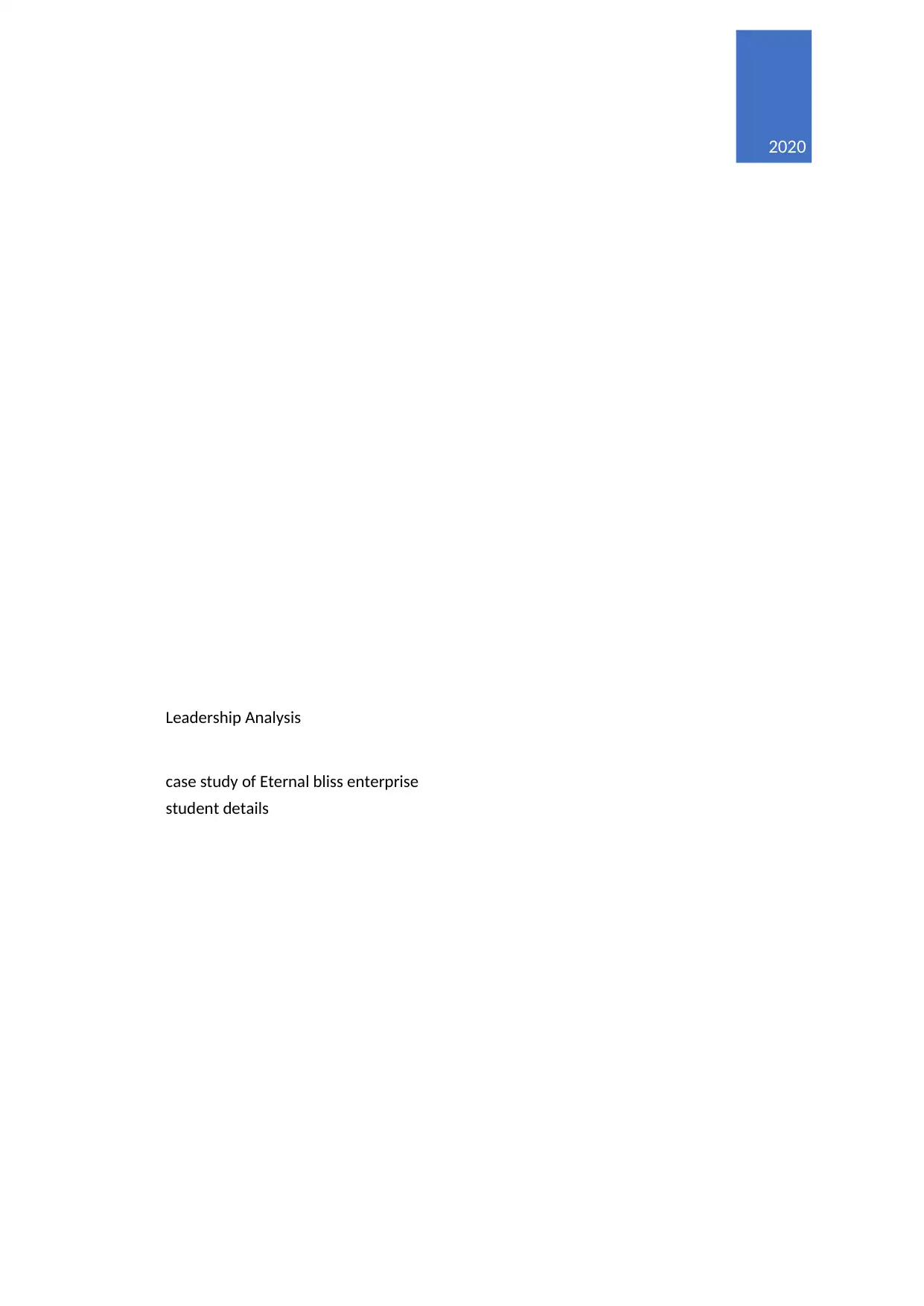
2020
Leadership Analysis
case study of Eternal bliss enterprise
student details
Leadership Analysis
case study of Eternal bliss enterprise
student details
Paraphrase This Document
Need a fresh take? Get an instant paraphrase of this document with our AI Paraphraser
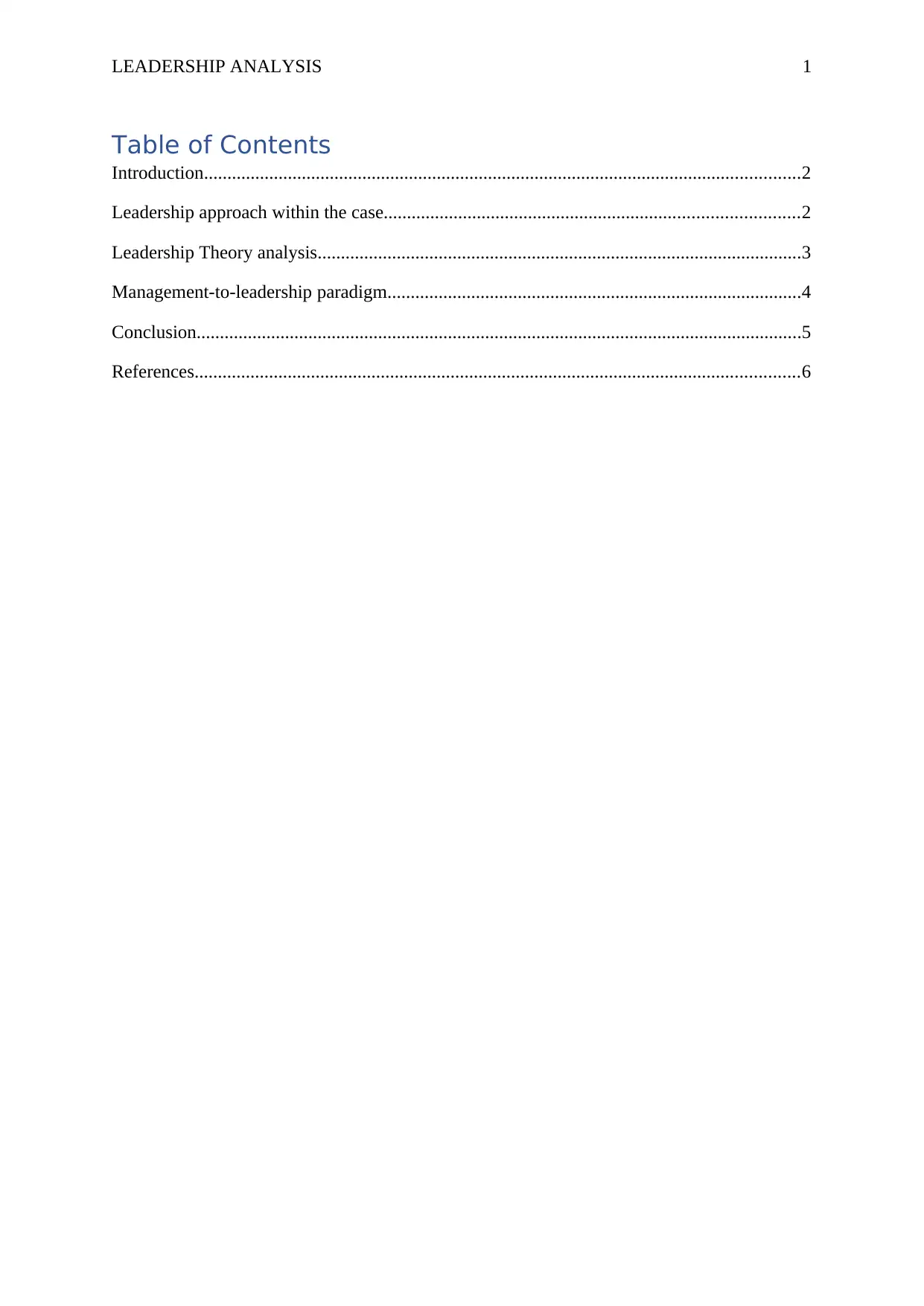
LEADERSHIP ANALYSIS 1
Table of Contents
Introduction................................................................................................................................2
Leadership approach within the case.........................................................................................2
Leadership Theory analysis........................................................................................................3
Management-to-leadership paradigm.........................................................................................4
Conclusion..................................................................................................................................5
References..................................................................................................................................6
Table of Contents
Introduction................................................................................................................................2
Leadership approach within the case.........................................................................................2
Leadership Theory analysis........................................................................................................3
Management-to-leadership paradigm.........................................................................................4
Conclusion..................................................................................................................................5
References..................................................................................................................................6
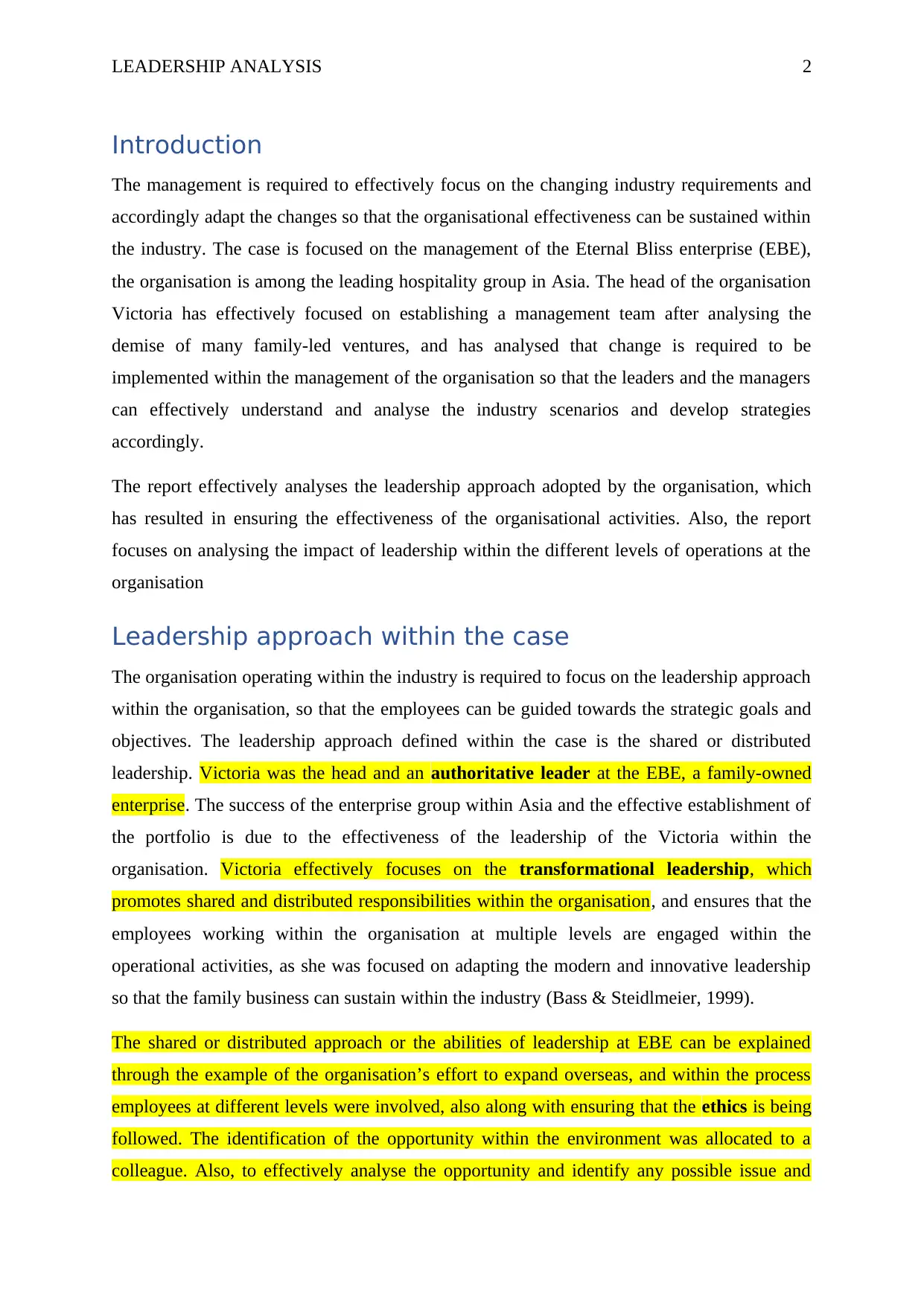
LEADERSHIP ANALYSIS 2
Introduction
The management is required to effectively focus on the changing industry requirements and
accordingly adapt the changes so that the organisational effectiveness can be sustained within
the industry. The case is focused on the management of the Eternal Bliss enterprise (EBE),
the organisation is among the leading hospitality group in Asia. The head of the organisation
Victoria has effectively focused on establishing a management team after analysing the
demise of many family-led ventures, and has analysed that change is required to be
implemented within the management of the organisation so that the leaders and the managers
can effectively understand and analyse the industry scenarios and develop strategies
accordingly.
The report effectively analyses the leadership approach adopted by the organisation, which
has resulted in ensuring the effectiveness of the organisational activities. Also, the report
focuses on analysing the impact of leadership within the different levels of operations at the
organisation
Leadership approach within the case
The organisation operating within the industry is required to focus on the leadership approach
within the organisation, so that the employees can be guided towards the strategic goals and
objectives. The leadership approach defined within the case is the shared or distributed
leadership. Victoria was the head and an authoritative leader at the EBE, a family-owned
enterprise. The success of the enterprise group within Asia and the effective establishment of
the portfolio is due to the effectiveness of the leadership of the Victoria within the
organisation. Victoria effectively focuses on the transformational leadership, which
promotes shared and distributed responsibilities within the organisation, and ensures that the
employees working within the organisation at multiple levels are engaged within the
operational activities, as she was focused on adapting the modern and innovative leadership
so that the family business can sustain within the industry (Bass & Steidlmeier, 1999).
The shared or distributed approach or the abilities of leadership at EBE can be explained
through the example of the organisation’s effort to expand overseas, and within the process
employees at different levels were involved, also along with ensuring that the ethics is being
followed. The identification of the opportunity within the environment was allocated to a
colleague. Also, to effectively analyse the opportunity and identify any possible issue and
Introduction
The management is required to effectively focus on the changing industry requirements and
accordingly adapt the changes so that the organisational effectiveness can be sustained within
the industry. The case is focused on the management of the Eternal Bliss enterprise (EBE),
the organisation is among the leading hospitality group in Asia. The head of the organisation
Victoria has effectively focused on establishing a management team after analysing the
demise of many family-led ventures, and has analysed that change is required to be
implemented within the management of the organisation so that the leaders and the managers
can effectively understand and analyse the industry scenarios and develop strategies
accordingly.
The report effectively analyses the leadership approach adopted by the organisation, which
has resulted in ensuring the effectiveness of the organisational activities. Also, the report
focuses on analysing the impact of leadership within the different levels of operations at the
organisation
Leadership approach within the case
The organisation operating within the industry is required to focus on the leadership approach
within the organisation, so that the employees can be guided towards the strategic goals and
objectives. The leadership approach defined within the case is the shared or distributed
leadership. Victoria was the head and an authoritative leader at the EBE, a family-owned
enterprise. The success of the enterprise group within Asia and the effective establishment of
the portfolio is due to the effectiveness of the leadership of the Victoria within the
organisation. Victoria effectively focuses on the transformational leadership, which
promotes shared and distributed responsibilities within the organisation, and ensures that the
employees working within the organisation at multiple levels are engaged within the
operational activities, as she was focused on adapting the modern and innovative leadership
so that the family business can sustain within the industry (Bass & Steidlmeier, 1999).
The shared or distributed approach or the abilities of leadership at EBE can be explained
through the example of the organisation’s effort to expand overseas, and within the process
employees at different levels were involved, also along with ensuring that the ethics is being
followed. The identification of the opportunity within the environment was allocated to a
colleague. Also, to effectively analyse the opportunity and identify any possible issue and
⊘ This is a preview!⊘
Do you want full access?
Subscribe today to unlock all pages.

Trusted by 1+ million students worldwide
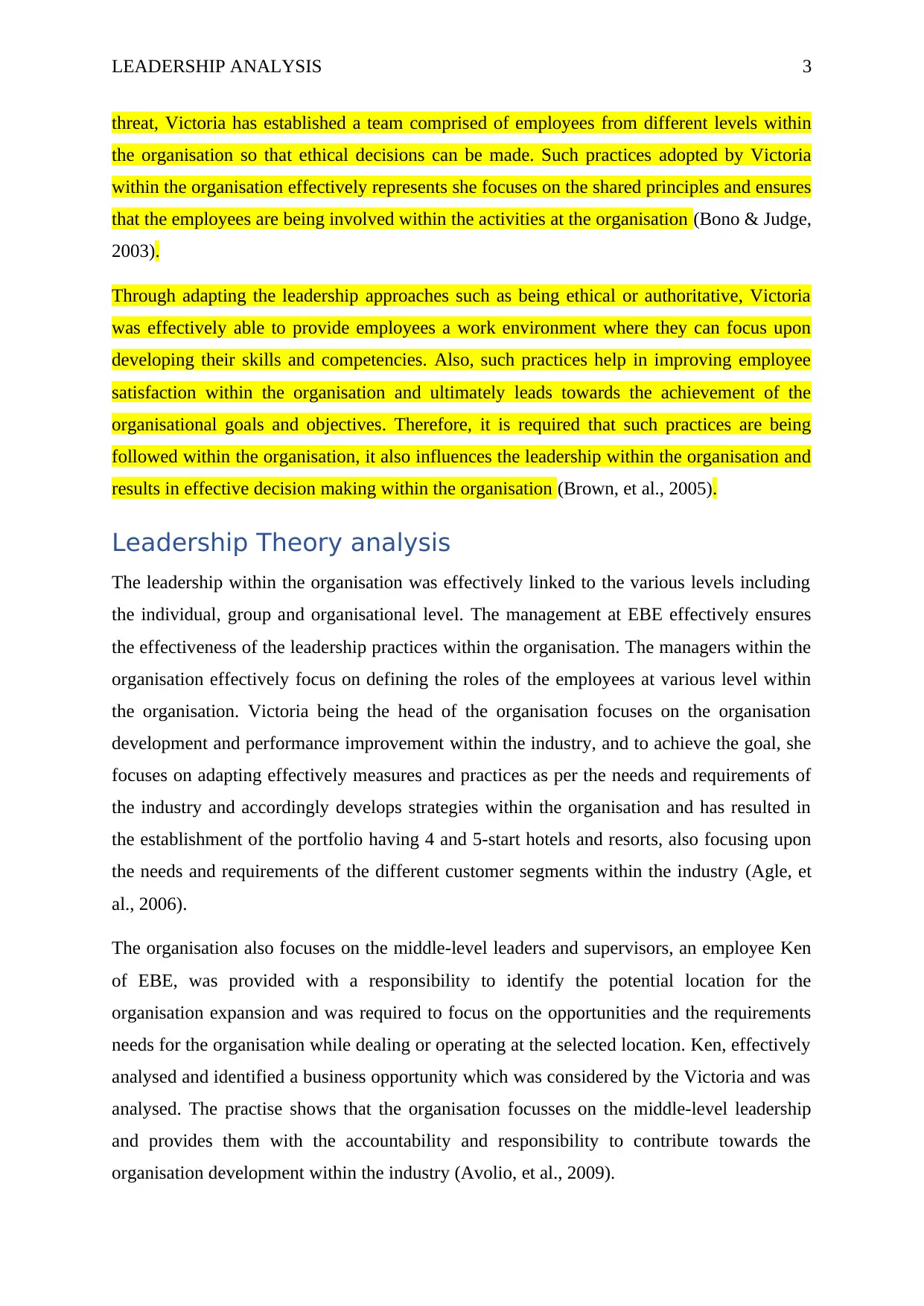
LEADERSHIP ANALYSIS 3
threat, Victoria has established a team comprised of employees from different levels within
the organisation so that ethical decisions can be made. Such practices adopted by Victoria
within the organisation effectively represents she focuses on the shared principles and ensures
that the employees are being involved within the activities at the organisation (Bono & Judge,
2003).
Through adapting the leadership approaches such as being ethical or authoritative, Victoria
was effectively able to provide employees a work environment where they can focus upon
developing their skills and competencies. Also, such practices help in improving employee
satisfaction within the organisation and ultimately leads towards the achievement of the
organisational goals and objectives. Therefore, it is required that such practices are being
followed within the organisation, it also influences the leadership within the organisation and
results in effective decision making within the organisation (Brown, et al., 2005).
Leadership Theory analysis
The leadership within the organisation was effectively linked to the various levels including
the individual, group and organisational level. The management at EBE effectively ensures
the effectiveness of the leadership practices within the organisation. The managers within the
organisation effectively focus on defining the roles of the employees at various level within
the organisation. Victoria being the head of the organisation focuses on the organisation
development and performance improvement within the industry, and to achieve the goal, she
focuses on adapting effectively measures and practices as per the needs and requirements of
the industry and accordingly develops strategies within the organisation and has resulted in
the establishment of the portfolio having 4 and 5-start hotels and resorts, also focusing upon
the needs and requirements of the different customer segments within the industry (Agle, et
al., 2006).
The organisation also focuses on the middle-level leaders and supervisors, an employee Ken
of EBE, was provided with a responsibility to identify the potential location for the
organisation expansion and was required to focus on the opportunities and the requirements
needs for the organisation while dealing or operating at the selected location. Ken, effectively
analysed and identified a business opportunity which was considered by the Victoria and was
analysed. The practise shows that the organisation focusses on the middle-level leadership
and provides them with the accountability and responsibility to contribute towards the
organisation development within the industry (Avolio, et al., 2009).
threat, Victoria has established a team comprised of employees from different levels within
the organisation so that ethical decisions can be made. Such practices adopted by Victoria
within the organisation effectively represents she focuses on the shared principles and ensures
that the employees are being involved within the activities at the organisation (Bono & Judge,
2003).
Through adapting the leadership approaches such as being ethical or authoritative, Victoria
was effectively able to provide employees a work environment where they can focus upon
developing their skills and competencies. Also, such practices help in improving employee
satisfaction within the organisation and ultimately leads towards the achievement of the
organisational goals and objectives. Therefore, it is required that such practices are being
followed within the organisation, it also influences the leadership within the organisation and
results in effective decision making within the organisation (Brown, et al., 2005).
Leadership Theory analysis
The leadership within the organisation was effectively linked to the various levels including
the individual, group and organisational level. The management at EBE effectively ensures
the effectiveness of the leadership practices within the organisation. The managers within the
organisation effectively focus on defining the roles of the employees at various level within
the organisation. Victoria being the head of the organisation focuses on the organisation
development and performance improvement within the industry, and to achieve the goal, she
focuses on adapting effectively measures and practices as per the needs and requirements of
the industry and accordingly develops strategies within the organisation and has resulted in
the establishment of the portfolio having 4 and 5-start hotels and resorts, also focusing upon
the needs and requirements of the different customer segments within the industry (Agle, et
al., 2006).
The organisation also focuses on the middle-level leaders and supervisors, an employee Ken
of EBE, was provided with a responsibility to identify the potential location for the
organisation expansion and was required to focus on the opportunities and the requirements
needs for the organisation while dealing or operating at the selected location. Ken, effectively
analysed and identified a business opportunity which was considered by the Victoria and was
analysed. The practise shows that the organisation focusses on the middle-level leadership
and provides them with the accountability and responsibility to contribute towards the
organisation development within the industry (Avolio, et al., 2009).
Paraphrase This Document
Need a fresh take? Get an instant paraphrase of this document with our AI Paraphraser
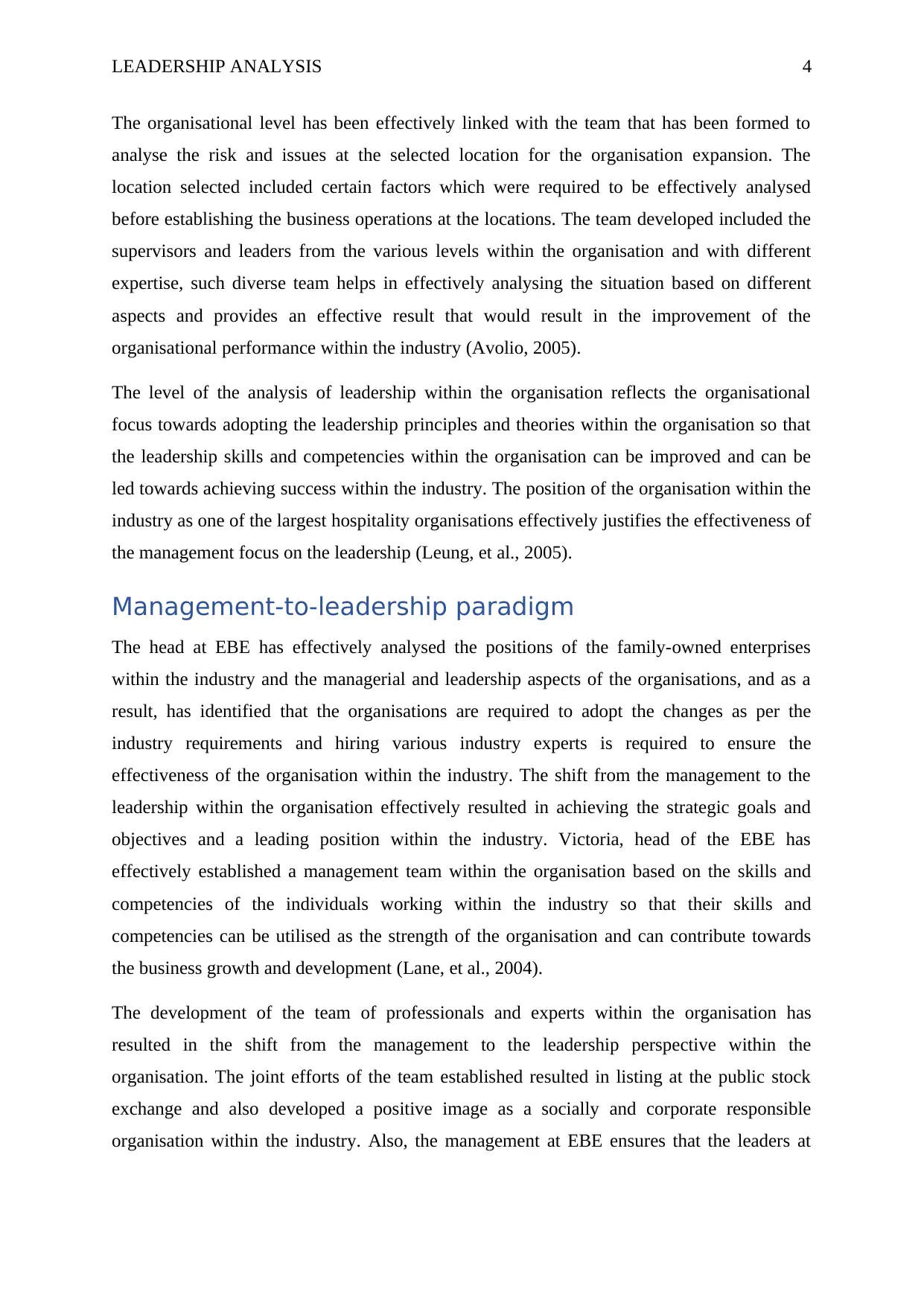
LEADERSHIP ANALYSIS 4
The organisational level has been effectively linked with the team that has been formed to
analyse the risk and issues at the selected location for the organisation expansion. The
location selected included certain factors which were required to be effectively analysed
before establishing the business operations at the locations. The team developed included the
supervisors and leaders from the various levels within the organisation and with different
expertise, such diverse team helps in effectively analysing the situation based on different
aspects and provides an effective result that would result in the improvement of the
organisational performance within the industry (Avolio, 2005).
The level of the analysis of leadership within the organisation reflects the organisational
focus towards adopting the leadership principles and theories within the organisation so that
the leadership skills and competencies within the organisation can be improved and can be
led towards achieving success within the industry. The position of the organisation within the
industry as one of the largest hospitality organisations effectively justifies the effectiveness of
the management focus on the leadership (Leung, et al., 2005).
Management-to-leadership paradigm
The head at EBE has effectively analysed the positions of the family-owned enterprises
within the industry and the managerial and leadership aspects of the organisations, and as a
result, has identified that the organisations are required to adopt the changes as per the
industry requirements and hiring various industry experts is required to ensure the
effectiveness of the organisation within the industry. The shift from the management to the
leadership within the organisation effectively resulted in achieving the strategic goals and
objectives and a leading position within the industry. Victoria, head of the EBE has
effectively established a management team within the organisation based on the skills and
competencies of the individuals working within the industry so that their skills and
competencies can be utilised as the strength of the organisation and can contribute towards
the business growth and development (Lane, et al., 2004).
The development of the team of professionals and experts within the organisation has
resulted in the shift from the management to the leadership perspective within the
organisation. The joint efforts of the team established resulted in listing at the public stock
exchange and also developed a positive image as a socially and corporate responsible
organisation within the industry. Also, the management at EBE ensures that the leaders at
The organisational level has been effectively linked with the team that has been formed to
analyse the risk and issues at the selected location for the organisation expansion. The
location selected included certain factors which were required to be effectively analysed
before establishing the business operations at the locations. The team developed included the
supervisors and leaders from the various levels within the organisation and with different
expertise, such diverse team helps in effectively analysing the situation based on different
aspects and provides an effective result that would result in the improvement of the
organisational performance within the industry (Avolio, 2005).
The level of the analysis of leadership within the organisation reflects the organisational
focus towards adopting the leadership principles and theories within the organisation so that
the leadership skills and competencies within the organisation can be improved and can be
led towards achieving success within the industry. The position of the organisation within the
industry as one of the largest hospitality organisations effectively justifies the effectiveness of
the management focus on the leadership (Leung, et al., 2005).
Management-to-leadership paradigm
The head at EBE has effectively analysed the positions of the family-owned enterprises
within the industry and the managerial and leadership aspects of the organisations, and as a
result, has identified that the organisations are required to adopt the changes as per the
industry requirements and hiring various industry experts is required to ensure the
effectiveness of the organisation within the industry. The shift from the management to the
leadership within the organisation effectively resulted in achieving the strategic goals and
objectives and a leading position within the industry. Victoria, head of the EBE has
effectively established a management team within the organisation based on the skills and
competencies of the individuals working within the industry so that their skills and
competencies can be utilised as the strength of the organisation and can contribute towards
the business growth and development (Lane, et al., 2004).
The development of the team of professionals and experts within the organisation has
resulted in the shift from the management to the leadership perspective within the
organisation. The joint efforts of the team established resulted in listing at the public stock
exchange and also developed a positive image as a socially and corporate responsible
organisation within the industry. Also, the management at EBE ensures that the leaders at
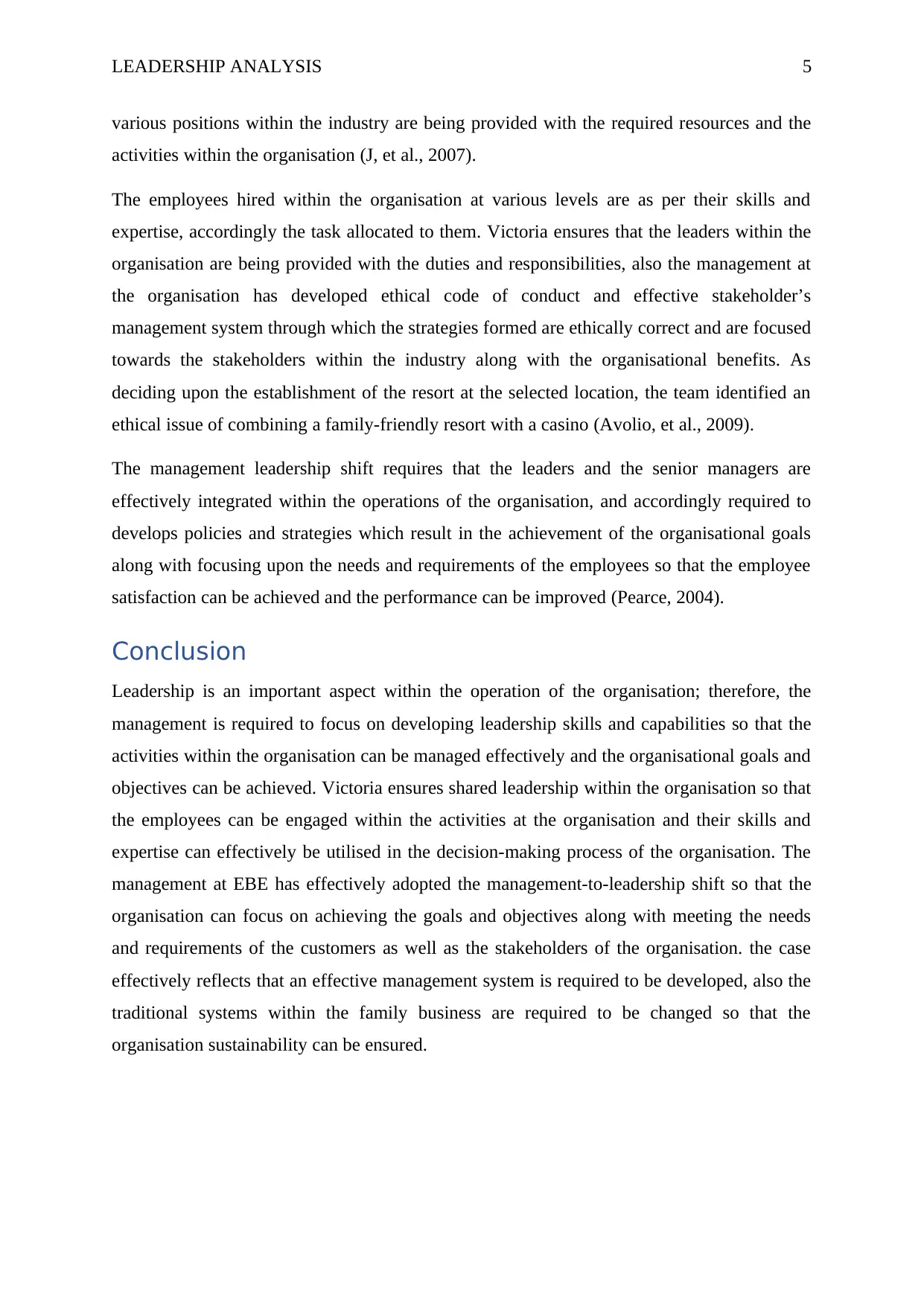
LEADERSHIP ANALYSIS 5
various positions within the industry are being provided with the required resources and the
activities within the organisation (J, et al., 2007).
The employees hired within the organisation at various levels are as per their skills and
expertise, accordingly the task allocated to them. Victoria ensures that the leaders within the
organisation are being provided with the duties and responsibilities, also the management at
the organisation has developed ethical code of conduct and effective stakeholder’s
management system through which the strategies formed are ethically correct and are focused
towards the stakeholders within the industry along with the organisational benefits. As
deciding upon the establishment of the resort at the selected location, the team identified an
ethical issue of combining a family-friendly resort with a casino (Avolio, et al., 2009).
The management leadership shift requires that the leaders and the senior managers are
effectively integrated within the operations of the organisation, and accordingly required to
develops policies and strategies which result in the achievement of the organisational goals
along with focusing upon the needs and requirements of the employees so that the employee
satisfaction can be achieved and the performance can be improved (Pearce, 2004).
Conclusion
Leadership is an important aspect within the operation of the organisation; therefore, the
management is required to focus on developing leadership skills and capabilities so that the
activities within the organisation can be managed effectively and the organisational goals and
objectives can be achieved. Victoria ensures shared leadership within the organisation so that
the employees can be engaged within the activities at the organisation and their skills and
expertise can effectively be utilised in the decision-making process of the organisation. The
management at EBE has effectively adopted the management-to-leadership shift so that the
organisation can focus on achieving the goals and objectives along with meeting the needs
and requirements of the customers as well as the stakeholders of the organisation. the case
effectively reflects that an effective management system is required to be developed, also the
traditional systems within the family business are required to be changed so that the
organisation sustainability can be ensured.
various positions within the industry are being provided with the required resources and the
activities within the organisation (J, et al., 2007).
The employees hired within the organisation at various levels are as per their skills and
expertise, accordingly the task allocated to them. Victoria ensures that the leaders within the
organisation are being provided with the duties and responsibilities, also the management at
the organisation has developed ethical code of conduct and effective stakeholder’s
management system through which the strategies formed are ethically correct and are focused
towards the stakeholders within the industry along with the organisational benefits. As
deciding upon the establishment of the resort at the selected location, the team identified an
ethical issue of combining a family-friendly resort with a casino (Avolio, et al., 2009).
The management leadership shift requires that the leaders and the senior managers are
effectively integrated within the operations of the organisation, and accordingly required to
develops policies and strategies which result in the achievement of the organisational goals
along with focusing upon the needs and requirements of the employees so that the employee
satisfaction can be achieved and the performance can be improved (Pearce, 2004).
Conclusion
Leadership is an important aspect within the operation of the organisation; therefore, the
management is required to focus on developing leadership skills and capabilities so that the
activities within the organisation can be managed effectively and the organisational goals and
objectives can be achieved. Victoria ensures shared leadership within the organisation so that
the employees can be engaged within the activities at the organisation and their skills and
expertise can effectively be utilised in the decision-making process of the organisation. The
management at EBE has effectively adopted the management-to-leadership shift so that the
organisation can focus on achieving the goals and objectives along with meeting the needs
and requirements of the customers as well as the stakeholders of the organisation. the case
effectively reflects that an effective management system is required to be developed, also the
traditional systems within the family business are required to be changed so that the
organisation sustainability can be ensured.
⊘ This is a preview!⊘
Do you want full access?
Subscribe today to unlock all pages.

Trusted by 1+ million students worldwide
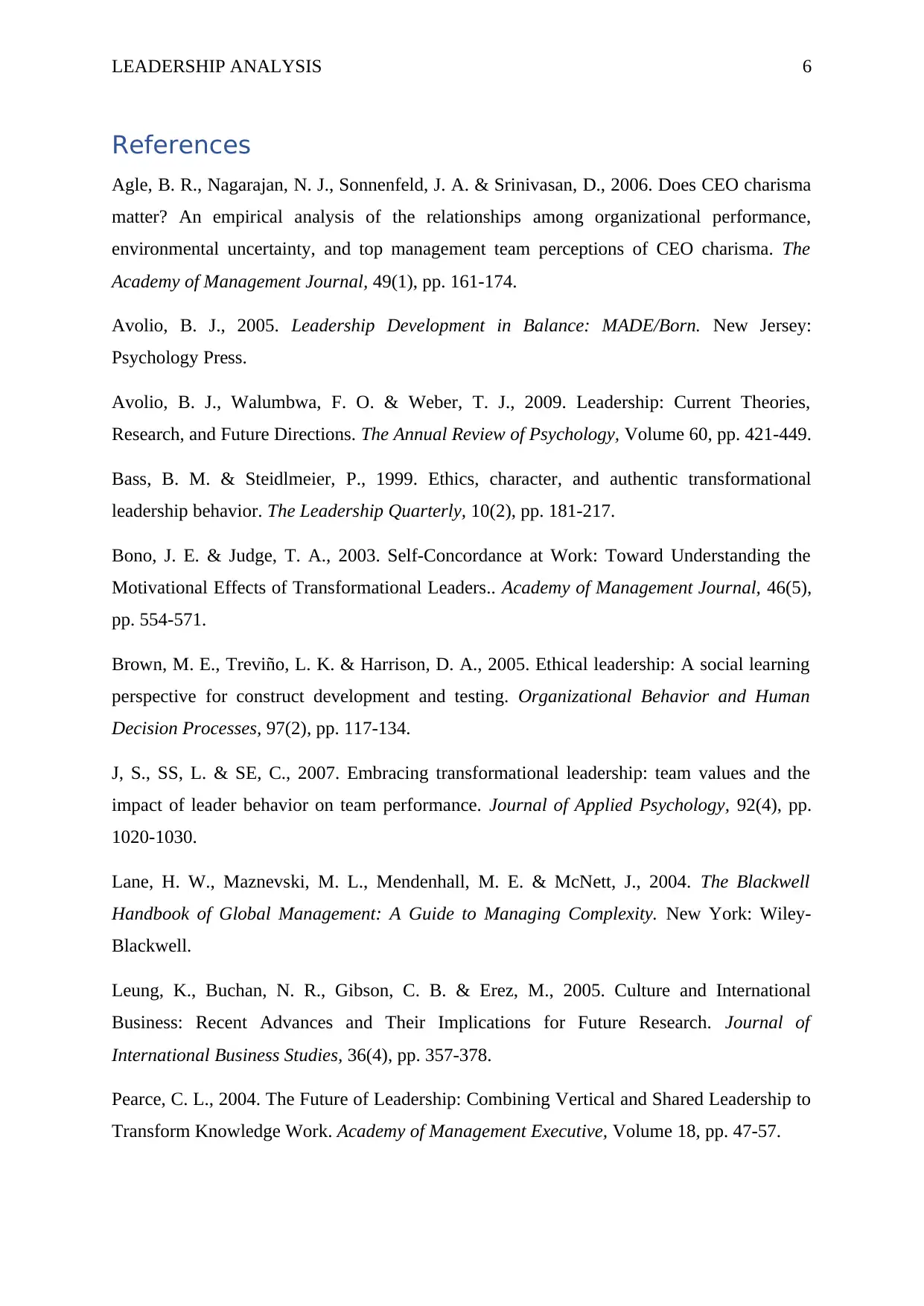
LEADERSHIP ANALYSIS 6
References
Agle, B. R., Nagarajan, N. J., Sonnenfeld, J. A. & Srinivasan, D., 2006. Does CEO charisma
matter? An empirical analysis of the relationships among organizational performance,
environmental uncertainty, and top management team perceptions of CEO charisma. The
Academy of Management Journal, 49(1), pp. 161-174.
Avolio, B. J., 2005. Leadership Development in Balance: MADE/Born. New Jersey:
Psychology Press.
Avolio, B. J., Walumbwa, F. O. & Weber, T. J., 2009. Leadership: Current Theories,
Research, and Future Directions. The Annual Review of Psychology, Volume 60, pp. 421-449.
Bass, B. M. & Steidlmeier, P., 1999. Ethics, character, and authentic transformational
leadership behavior. The Leadership Quarterly, 10(2), pp. 181-217.
Bono, J. E. & Judge, T. A., 2003. Self-Concordance at Work: Toward Understanding the
Motivational Effects of Transformational Leaders.. Academy of Management Journal, 46(5),
pp. 554-571.
Brown, M. E., Treviño, L. K. & Harrison, D. A., 2005. Ethical leadership: A social learning
perspective for construct development and testing. Organizational Behavior and Human
Decision Processes, 97(2), pp. 117-134.
J, S., SS, L. & SE, C., 2007. Embracing transformational leadership: team values and the
impact of leader behavior on team performance. Journal of Applied Psychology, 92(4), pp.
1020-1030.
Lane, H. W., Maznevski, M. L., Mendenhall, M. E. & McNett, J., 2004. The Blackwell
Handbook of Global Management: A Guide to Managing Complexity. New York: Wiley-
Blackwell.
Leung, K., Buchan, N. R., Gibson, C. B. & Erez, M., 2005. Culture and International
Business: Recent Advances and Their Implications for Future Research. Journal of
International Business Studies, 36(4), pp. 357-378.
Pearce, C. L., 2004. The Future of Leadership: Combining Vertical and Shared Leadership to
Transform Knowledge Work. Academy of Management Executive, Volume 18, pp. 47-57.
References
Agle, B. R., Nagarajan, N. J., Sonnenfeld, J. A. & Srinivasan, D., 2006. Does CEO charisma
matter? An empirical analysis of the relationships among organizational performance,
environmental uncertainty, and top management team perceptions of CEO charisma. The
Academy of Management Journal, 49(1), pp. 161-174.
Avolio, B. J., 2005. Leadership Development in Balance: MADE/Born. New Jersey:
Psychology Press.
Avolio, B. J., Walumbwa, F. O. & Weber, T. J., 2009. Leadership: Current Theories,
Research, and Future Directions. The Annual Review of Psychology, Volume 60, pp. 421-449.
Bass, B. M. & Steidlmeier, P., 1999. Ethics, character, and authentic transformational
leadership behavior. The Leadership Quarterly, 10(2), pp. 181-217.
Bono, J. E. & Judge, T. A., 2003. Self-Concordance at Work: Toward Understanding the
Motivational Effects of Transformational Leaders.. Academy of Management Journal, 46(5),
pp. 554-571.
Brown, M. E., Treviño, L. K. & Harrison, D. A., 2005. Ethical leadership: A social learning
perspective for construct development and testing. Organizational Behavior and Human
Decision Processes, 97(2), pp. 117-134.
J, S., SS, L. & SE, C., 2007. Embracing transformational leadership: team values and the
impact of leader behavior on team performance. Journal of Applied Psychology, 92(4), pp.
1020-1030.
Lane, H. W., Maznevski, M. L., Mendenhall, M. E. & McNett, J., 2004. The Blackwell
Handbook of Global Management: A Guide to Managing Complexity. New York: Wiley-
Blackwell.
Leung, K., Buchan, N. R., Gibson, C. B. & Erez, M., 2005. Culture and International
Business: Recent Advances and Their Implications for Future Research. Journal of
International Business Studies, 36(4), pp. 357-378.
Pearce, C. L., 2004. The Future of Leadership: Combining Vertical and Shared Leadership to
Transform Knowledge Work. Academy of Management Executive, Volume 18, pp. 47-57.
Paraphrase This Document
Need a fresh take? Get an instant paraphrase of this document with our AI Paraphraser

LEADERSHIP ANALYSIS 7
1 out of 8
Related Documents
Your All-in-One AI-Powered Toolkit for Academic Success.
+13062052269
info@desklib.com
Available 24*7 on WhatsApp / Email
![[object Object]](/_next/static/media/star-bottom.7253800d.svg)
Unlock your academic potential
Copyright © 2020–2025 A2Z Services. All Rights Reserved. Developed and managed by ZUCOL.





